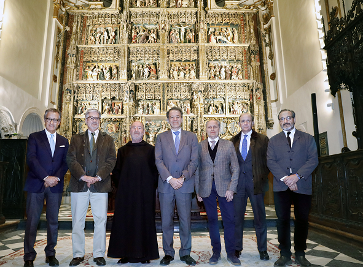New decorative lighting inside the church of the Royal Monastery of Santa María de El Paular
The Ministry of Education, Culture and Sport’s Director General for Fine Arts and Cultural Heritage, Luis Lafuente Batanero, and the chairman of Fundación Iberdrola España, Manuel Marín, officially switched on 5th April the new ornamental lighting in the church of the Royal Monastery of Santa María de El Paular, in Rascafría (Madrid). Also taking part in the event were the prior of the monastery, Miguel Muñoz, and the president of the Association of Friends of El Paular, Antonio Más Guindal.

The new system helps to highlight the most valuable piece in the monumental complex.
The renovation project was made possible by a cooperation agreement between Fundación Iberdrola España and the Directorate General of Fine Arts and Cultural Heritage signed in March 2016. Its goal was to draw up and execute a decorative lighting project for the church that was in keeping with the needs and importance of its cultural assets.
The work, which started at the beginning of 2017, makes use of the most advanced LED technology, paying close attention to the installation’s sustainability and energy savings, which will reduce consumption by 74% compared to the previous equipment. Also, from an environmental point of view, this greater energy efficiency reduces CO2 emissions by 2.1 tonnes annually.
The altarpiece: a scene-by-scene lighting system
The new system helps to highlight the most valuable piece in the monumental complex: the magnificent multicoloured alabaster altarpiece, created for the monastery by artists from the school of Juan Guás at the end of the 15th century.
The monastery of Santa María de El Paular, which is located in the municipality of Rascafría on the slopes of the Sierra de Guadarrama facing Madrid, is a former Carthusian Monastery and was declared an Asset of Cultural Interest with the category of Monument in 1876.
The monastery of Santa María de El Paular, which is located in the municipality of Rascafría on the slopes of the Sierra de Guadarrama facing Madrid, is a former Carthusian Monastery and was declared an Asset of Cultural Interest with the category of Monument in 1876.
